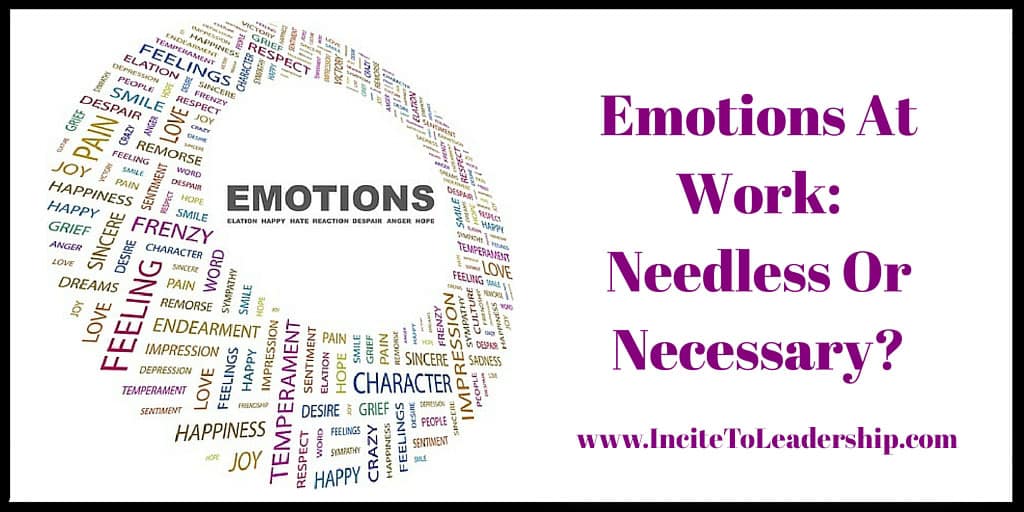Emotions At Work: Needless Or Necessary?

Last weekend I sat on the sidelines as my 14-year-old son played a local tennis tournament. I often compare the court side behavior of these young men. Whereas many of them grunt and reprimand themselves loudly after a bungled point, my son generally has a stoic demeanor where it’s hard to tell if he’s feeling happy, pressured or frustrated. Usually, I’m happy that my son’s not the one throwing his racquet down. This past weekend, though, I wanted to see more passion. I wanted to witness him tapping into his fighting competitive drive.
 Don’t worry — I kept quiet. As the parent of a teenager, I have learned that anything I advocate for is likely to be the last thing in the world he wants a part of.
Don’t worry — I kept quiet. As the parent of a teenager, I have learned that anything I advocate for is likely to be the last thing in the world he wants a part of.
As an executive coach and leadership consultant, watching those boys and how they displayed or hid their emotions also made me think of the very real debate being waged at workplaces across the U.S.: What is the role of emotions in the workplace?
Lately, there have been two camps or philosophies on the place of emotions in the workplace.
The first, an outgrowth of the “boys don’t cry” school of thought, maintains that work is work and not a place for much display of emotion. These proponents argue that work should be a place of logical, rational thought, where you don’t give into emotional thinking. And you certainly don’t display any emotions you do feel to those around you because it’s both not professional and leaves you too vulnerable.
The second school of thought, getting increasingly more airtime since Brene Brown’s Ted talk, argues that emotions and vulnerability are part of who we are. If we want true authenticity and power at work, we need to be willing to feel and acknowledge our emotions while being, as Brown terms it, “more wholehearted.”
But wholehearted isn’t often comfortable. I was speaking with one of my clients recently and he was telling me about a conversation with a vendor. My client was pushing the vendor to offer better services, and the vendor, potentially scared to lose the account, was getting quite emotional during the conversation. As my client related the conversation, he acknowledged how uncomfortable he felt with the vendor’s raw emotions and wondered why he felt so off-balance in responding.
As a workplace professional, it’s hard to know whether you should lean into your emotions and authenticity or “never let them see you sweat.” To help you navigate this dilemma, here are three very important considerations to reflect on as you begin to find your comfort zone.
What To Weigh When Dealing With Workplace Emotions:
1. What Happened Before You Got So Emotional?
Talking to both my clients and hundreds of others about challenging workplace situations, one thing has become clear to me. It’s very rare to have a workplace situation escalate from zero to emotional in one interaction. What’s much more common is a layering of issues. This means that by the time one or both people reach an emotionally-charged moment in their relationship, the reaction is no longer about this one incident but about the all the other incidents that have come before this.
Instead of addressing and resolving your workplace challenges right away, you’ve allowed the slow burn to keep festering. This means what you need to do, more than work through that one issue, is to repair any cracks in your relationships that have developed.
And if someone’s that upset with you at work? It’s worth thinking through what signs of frustration you might have missed (or avoided) dealing with earlier instead of addressing head-on when they first popped up.
2. Don’t Completely Hide Your Emotions
While it seems like it might be safer to err on the side of non-emotionality at work, there’s evidence to argue that it’s not as foolproof a strategy as it seems.
People who actively hide their emotions end up having blank expressions on their faces that are indecipherable to others. Not only does hiding your emotions make you unreadable, it can be jarring for the person looking at you. We trust people when we understand them and their motivations. If people expect to read an emotion on your face and see none, they might begin to find you untrustworthy.
If this happens, the result might be that instead of maintaining the relationship because you stayed composed, your lack of emotionality could create barriers to building true understanding and relate-ability.
Additionally, even when you think you’re hiding your emotions, they often “leak out” in non-verbal ways — signaling that you’re hiding something.
3. Use Less Theory And More Practicality
When clients explain their theories to me about whether people should or shouldn’t be emotional at work, my response is always this: “How’s it working for you?”
The truth is that different workplaces have different “rules of engagement.” Where some startups (and sports leagues) have loud and volatile ways of expressing disagreement, other environments value a calm demeanor and rational evidence-based arguments. These types of cultures can even differ from team to team within the same organization. Some leaders thrive on, and cultivate spirited discussions, while others, perhaps themselves conflict avoidant, label the more emotional of their staff as “troublemakers.”
 I’ve known “hotheads” in the workplace to be successful either in spite of — or because of —their temper and energy. Yet those same people in a different environment might be labeled “unpredictable” and “not executive material” due to their outbursts.
I’ve known “hotheads” in the workplace to be successful either in spite of — or because of —their temper and energy. Yet those same people in a different environment might be labeled “unpredictable” and “not executive material” due to their outbursts.
First off, it pays in effectiveness dividends for you to be aware of what type of environment and people you are dealing with. Then, it’s important for you to decide what kind of team and environment you want to lead.
Substantial team research detailed by Charles Duhigg in his new book Smarter Faster Better validates the fact that high-performing teams offer both emotional safety and ways for their members to productively disagree. This means that despite all the strong stands people take on what’s “proper” and “right” at work, it’s up to you to find the right emotional tone that builds the communication and rapport you need to both engage in effective workplace conflict as well as collaborate easily in the culture you find yourself.
Article originally published on Forbes.com on June 6, 2016.